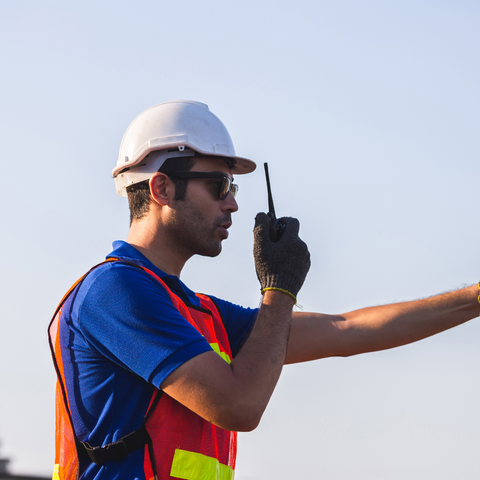Two-way radios are a reliable form of communication technology that can benefit many professions and individuals. Because two-way radios use RF and UHF technology to operate, the FCC or Federal Communications Commission monitors them. With limited frequencies and more communicators than frequencies, there can be a lot of grey area when it comes to privacy.
Consequently, the FCC created licenses that users are required to pass to operate their radios on specific frequencies. This is where the terms licensed, and license-free radios come into play. There are more details behind licensing than just the aforementioned; to learn more about the benefits of licensed vs. license-free and who could reap those benefits, keep reading.
What are License-Free Radios?
License-free radios are two-way radios that can be operated without a license and work on a fixed band. These two-way radios come pre-programmed to automatically work on a fixed band so they can be operated right out of the box. Fixed band means radio communication between two specific points.
Therefore, these radios rend to have a smaller coverage area between radios; the area tends to range 1-2 miles. License free radios operate solely on general radio services. Consequently, there is a higher chance of interference and invasion of privacy. However, these issues may not pose as problems for some users, especially when weighed next to the benefits of license-free radios.
What are the Benefits of License-Free Radios?
License-free radios come with many benefits. For instance, these radios do not require any system installation or set up; they are open the box and ready to use (FCC Licensing). Because of the simplicity of license-free radios, it is a common misconception that the radios are not as reliable in technology and design.
License-free radios are just as powerful and up to date in technology as licensed radios; they just have distinctive features. Another excellent feature and benefit for license-free radios is they all work on the same channels. This benefit makes these radios beginner friendly. Lastly, because the radios are license free, owners and users do not have to worry about annual license renewals.
Overall, license-free radios come with a multitude of benefits related to ease of access and use without sacrificing quality.
Who Would Benefit from License-Free Radios?
Because license-free radios tend to have lower prices and they are so user friendly, there are many types of professions and individuals who can benefit from owning these radios.
- Event planners
- Emergency shelter volunteer organizations
- Schools
- Hospitals
- Stadiums (sports, concerts, etc.)
- Theme parks
- Families
- Hiking/Camping groups
Two-way radios are a great source of reliable communication so high risk places like hospitals and schools would benefit from that reliability. In most cases of using radios in either venue, the user will only now the basics of radios. Therefore, license-free radios are perfect for them.

On the other side of the spectrum, families can benefit from two-way radios. For instance, families go on long road trips in the summer and around the holidays. In the U.S. cell signal can be spotty in most rural areas.
License-free radios are a great tool for communications between family cars. From the quick use and convenient features, license-free radios are a great option.
License-Free Radio Options:
There are several different manufacturers of license-free radios. One of the top license-free radio makers is Midland. These radios are made with the adventurers in mind.
License-Free Radios for the Outdoors:
- X-Talker T51
- X-Talker T61
- X-Talker T71
- X-Talker T10
- X-Talker T31
The X-Talker two-way radio series is made specifically for outdoor applications. Although these radios do not require a license for operation, the sound quality and range are still optimal.
The X-Talker license-free radio range is anywhere between 20-38 miles. Moreover, these radios can access a weather alert and operate on FRS or Family Radio Service.
The Midland X-Talkers are great for hiking, camping, hunting trips, and more!
Below is a chart showing distinctions between each radio.
|
|
T51 |
T61 |
T71 |
T10 |
T290/295 |
T31 |
|
Range |
28 miles |
32 miles |
38 miles |
20 miles |
40 miles |
26 miles |
|
Channel |
22 |
36 |
36 |
22 |
22 |
22 |
|
Requires License |
No |
No |
No |
No |
YES |
No |
|
Anything else important. |
FRS and Weather alert technology |
FRS, weather alert, and weather scan |
FRS, weather alert, weather scan, and USB charging ability |
FRS and Weather alert technology |
GMRS, weather alert, and weather scan |
FRS and Weather alert technology |
What are Licensed Radios?
Licensed radios are two-way radios that require the user to have a license to operate the radio. Moreover, these radios need special systems that need to be set up with the radio. The system is set up in accordance with the type of license you have, to provide the right amount and types of coverage. Licensed radios typically cover up to one hundred miles. These systems are multicast which means they are interconnected.
Licensed radios and the users’ licenses are regulated by the U.S. FCC or the Federal Communications Commission. The FCC maintains five different licensing systems:
- Universal licensing system (ULS)
- Broadcast radio and television electronic filing system (CDBS)
- Cable operation and licensing system (COALS)
- International bureau electronic filing system (MyIBFS)
- OET experimental licensing system electronic filing
The largest difference between each of these licenses is the frequencies that the radios operate within. Licensed radios allow the user to operate radio waves outside of general service frequencies legally (The Advantages of Licensed). Because these two-way radios are allowed to operate in over one hundred miles and hundreds to thousands of frequencies, these radios are immensely powerful.
With superior coverage and a greater frequency selection, the lower the possibility of interference and communications being overheard. When many people only have access to a few frequencies, there will be overlap between radios meaning communications can be missed. Moreover, other radios can overhear your communications if they are on your frequency.
Because licensed radios operate on their own frequencies, those users have secure communications compared to license-free radios. For this reason, licensed radios are ideal for emergency workers, military, and others.
What are the Benefits of Licensed Radios?
The benefits of licensed radios are numerous. From uninterrupted and private communications to a larger communication range, licensed radio users have a lot of flexibility. If the range your two-way radio comes with is not enough, it can be extended with repeaters.
Licensed radios also feature a long-lasting battery life. This is an important feature because those who use these radios often rely on them for extended periods of time. Lastly, licensed radio users can add the ability to use additional applications like voice recording, GPS tracking, and telemetry.
These applications are ideal for emergency communication workers like firefighters, EMTs, and police officers. Applications like GPS are great additions to a traditional two-way radio to aid in rescue missions or if a team member is in danger, they can be located easier.
Who Would Benefit from Licensed Radios?
Licensed radios are a great option for those looking to use two-way radios for prolonged periods of time and far distances.
- Police officers
- Military
- Firefighters
- EMTs
- Construction crews
- Roadwork crews
- Park rangers

All these professions rely on critical and dependable communication. Licensed radios provide secure communications from private frequencies. Workers like police officers need privacy when communicating to ensure public safety. To learn more about licenses offered by the Federal Communications Commission, go here.
…
From emergency workers to event planners, two-way radios are a great tool for reliable and consistent communications. License-free and licensed radios each have unique features and benefits. License-free radios are optimal for those who are two-way radio beginners and are looking for a radio that is simple and only needs to communicate in a small area.
Licensed radios are the preferred radio from critical communications professionals like police officers, firefighters, and military workers. Known for uninterrupted and secure communications, licensed radios offer a wider range of communication and privacy. We hope this article provided insight on the differences between licensed and license-free radios and gave you the necessary information to choose which radio is right for you.
Works Cited
“FCC Licensing Info.” Nu Radios, https://nuradios.com/fcc-info/.
“Licensing.” Federal Communications Commission, https://www.fcc.gov/licensing-databases/licensing.
“The Advantages of Licensed vs Unlicensed Radios.” Minerva, https://minerva.ae/the-advantages-of-licensed-vs-unlicensed-radios/.
How to Decide if Buying or Renting a Radio is right for you

